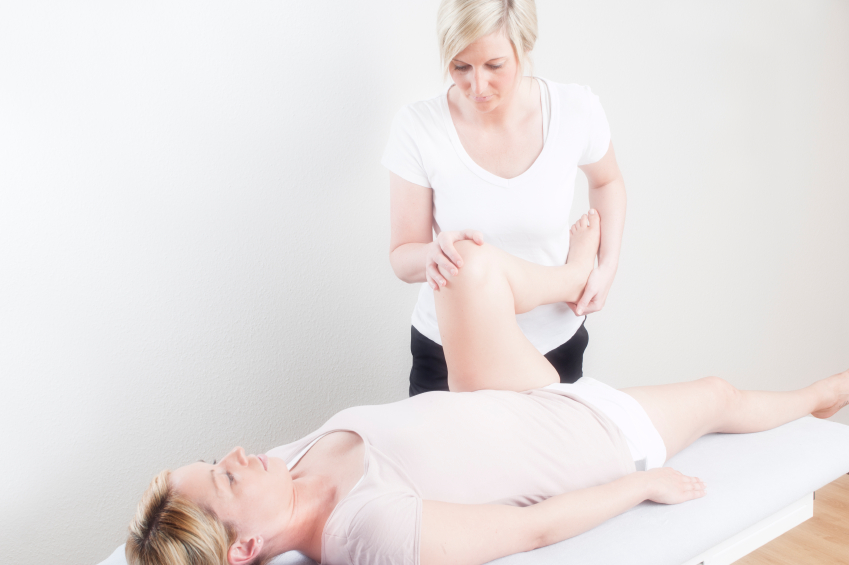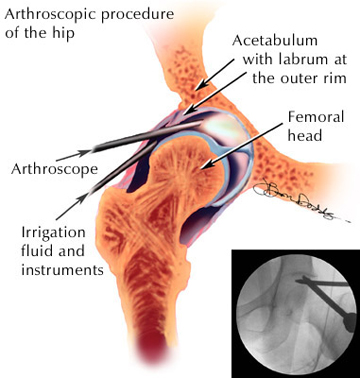Hip Arthroscopy

Tid Bits of Info
- If your hip hurts or feels as if it cannot move normally seek medical advice.
- Most of the Labral tears are in the front aspect of the joint and the pain is felt in the groin area.
- Maintaining good flexibility and strength can alleviate a lot of the symptoms in most cases.
- Placing too much weight on the involved hip in the initial days of the post-op time period can cause more damage and ruin the repair of the torn Labrum.
- Seek advice from your Physical Therapist to ensure proper progression of the post-op regimen.
Damage to the hip join is painful and may result in a change in lifestyle. In the past, many people had to live with the discomfort because there was not really any good options for treatment. During the last 10+ years, treatments have developed that can “fix” the hip via an arthroscopic surgical procedure. More and more doctors have developed an expertise in hip arthroscopy. Coupled with advancing rehabilitation techniques and protocols, this procedure has made a way for more hips to be surgically corrected and has allowed patients to return to full activity in a much faster pace.
Damages to the Hip Joint
A wide range of activities can cause damage to the internal aspect of the hip joint. Repetitive motions and actions of the joint can cause injury. These are often associated particular activitis that someone enjoys performing. For example, the repetitive kicking of a soccer ball or heavy bag, or twisting related to a golf swing can cause damage. On the other hand, there are also traumatic injuries to the joint usually attributed to high velocity or impact activities. Examples include high impact sports like a football tackle or down hill skiing crash.
The Structure of the Hip Joint
The human hip joint is designed for motion and stability. While it is a “ball-and-socket” joint similar to the shoulder, it has a much deeper depth of the socket. This increased depth enables the bones to be more stable, but continue to move in every plane of motion. Similarly to the shoulder joint the walls and rim of the “socket” have a fibro-cartilage Labrum attached to it. This Labrum helps in lubrication of the joint by creating a seal, congruency of the joint surfaces which adds to the stability of the joint and it helps to disperse and absorb compressive and sheer forces. The hip joint relies on the bony construction, ligaments and muscles for its stability. It must be able to withstand a tremendous amount of force when a person is performing the activities of daily living and athletic type movements.
Damages to the Labrum
As we’ve already mentioned, repititive actions or traumatic impacts can damage the internal aspect of the joint. The Labrum is commonly injured and it seldom heals on its own. People who suffered injuries to the Labrum used to have to live with the pain nd adapt their lifestyle to the injury. Hip Arthroscopy has made a way for people to recover from these injuries. Surgeons use a flexible arthroscope to visualize and repair the damaged internal structures. For the purpose of this blog, we will concentrate on the repair of the hip joint Labrum.
What to Expect with Hip Arthroscopy
If a patient is suffering from hip pain related to the internal aspect of hip joint, the surgeon may request the patient to visit an MRI center and have “pictures” taken of their damaged, painful hip. The surgeon will order the MRI to be performed “with contrast” which is similar to a dye that reveals damage to the fibro-cartilage Labrum more effectively. The surgeon might have the hip joint injected with cortisone at the same time that the dye is placed in the joint via needle. This cortico-steroid injection will often time reduce the patient’s pain level significantly by decreasing the inflammation within the joint. The surgeon will determine if the damage is severe enough to warrant going through the procedure.
During the surgical procedure, the surgeon will remove any damaged or frayed fibro-cartilage and repair it if necessary with a suture/barb that will hold it in place until the patient’s body naturally heals the Labrum “back to the bone.”
PAIN: The pain tolerance of patients differs greatly, but hip arthroscopic surgeries are generally painful. The most intense pain is felt within the first two weeks of the surgery. Medication and ice are helpful ways to manage pain. Additionally, the patient can try gentle motion, gentle mobilization techniques, and exercise appropriate for the acute post-op phase of healing to help reduce pain.
WEIGHT-BEARING AND ASSISTIVE DEVICES: The surgeon should be able to give you an idea what your weight bearing status will be following the procedure. In most cases, you will remain non-weight bearing or partial weight bearing for several days to weeks. This is determined by the amount of damage to the joint structures. If the surgeon “debrides” or removes the injured joint structures, the time on crutches will be reduced. Often times in this situation, the patient is told to weight bear as tolerated while using crutches. In this situation, the surgeon might have you wear a brace on your knee of the involved leg because the entire leg musculature will be extremely weak. If the structure is “repaired” or sutured, the amount of weight bearing forces applied to the repair site will be drastically reduced. Many times, the patient is completely non-weight bearing for several weeks if a repair is performed.
MOTION: Your surgeon will determine when the invovled hip can begin movement and how much movement it can stand. Prior to surgery, it is hepful to maintain as much motion as possible. Following surgery, there is usually a restriction on all motions, but the most painful motions are usually flexion, internal and external rotations. Your surgeon will determine the limits based on what he had to do during the surgery. If the Labrum is repaired during surgery, the repair site must be protected from compressive and sheer forces. Too much or aggressive motion too quickly can cause damage to the repair site.
Driving: You should never drive if you are under the influence of pain medications. Following surgery, you will not be able to drive until you are allowed to put your full weight on the involved foot. If the left hip is repaired, you will be ok to drive as soon as you can get in and out of the “driver’s seat.” Unfortunately, if it is your right hip that is surgically corrected, then you will have to wait until you can put your full body weight on your right lower extremity.
Returning to work: This decision will have to be made by you and your doctor. This is fully dependent upon the type of job that you have. If you have to walk or be weight-bearing most of the day, you should plan to take several days to weeks off based on what is done during the surgery. If you have a sedentary job, you might be able to return with in the first week of the post- op period. Ultimately, your doctor will have to make this decision, and you should be wise enough to follow the doctor’s instructions. Placing too much weight on the surgically corrected hip too soon can cause damage to the repair site and/or slow down the healing process drastically by increasing the amount of inflammation in the hip joint.
Having fun: You, your doctor and your Physical Therapist can decide when you return to the “fun” things in your life. Workouts, dancing, hiking, recreational sports, gardening, shopping and any other weight bearing activity can begin to take place when the surgically repaired Labrum is fully healed. The time frame for complete healing is dependent upon how severe the damage was in the first place. In most cases, the first 3 weeks requires a relatively sedentary lifestyle. The time period between week 4 and 12 will be the time when most of the healing commences. During this time period, your Physical Therapist can guide your progression and help to restore your full function.
Hip arthroscopy has advanced over the course of the past decade. It has enabled the surgeon to “look” inside the joint and “fix” the damaged internal structures. Prior to this surgical technique, patients usually changed and modified their lifestyle to avoid aggravating the involved hip. Today, this procedure and proper/extensive post –op rehabilitation often times enables a patient to return to their active lifestyle without pain and loss of function.


























Certain special tests can be used to diagnosis hip labral tears such as the hip scour test and a patient may ambulate with a Trendelenburg (hip drops down on the right side when standing on the left and vice versa) gait secondary to pain.
Certain special tests can be used to diagnosis hip labral tears such as the hip scour test and a patient may ambulate with a Trendelenburg (hip drops down on the right side when standing on the left and vice versa) gait secondary to pain.
Certain special tests can be used to diagnosis hip labral tears such as the hip scour test and a patient may ambulate with a Trendelenburg (hip drops down on the right side when standing on the left and vice versa) gait secondary to pain.